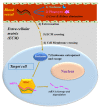Potential Application of Small Interfering RNA in Gastro-Intestinal Tumors
- PMID: 36297407
- PMCID: PMC9612316
- DOI: 10.3390/ph15101295
Potential Application of Small Interfering RNA in Gastro-Intestinal Tumors
Abstract
Despite the progress made in the diagnoses and therapy of gastrointestinal cancers, these diseases are still plagued by a high mortality. Thus, novel therapeutic approaches are urgently required. In this regard, small interfering RNA (siRNA), double-stranded RNA molecules able to specifically target the mRNA of pathological genes, have the potential to be of therapeutic value. To be effective in the human body, siRNAs need to be protected against degradation. Additionally, they need to target the tumor, leaving the normal tissue untouched in an effort to preserve organ function. To accomplish these tasks, siRNAs have been formulated with smart delivery systems such has polymers and lipids. While siRNA protection is not particularly difficult to achieve, their targeting of tumor cells remains problematic. Here, after introducing the general features of gastrointestinal cancers, we describe siRNA characteristics together with representative delivery systems developed for gastrointestinal cancers. Afterward, we present a selection of research papers employing siRNAs against upper- and lower- gastrointestinal cancers. For the liver, we also consider papers using siRNAs to combat liver cirrhosis, a relevant risk factor for liver cancer development. Finally, we present a brief description of clinical trials employing siRNAs for gastrointestinal cancers.
Keywords: delivery systems; gastro-intestinal cancer; liver fibrosis; siRNAs.
Conflict of interest statement
The authors declare no conflict of interest. The founding sponsors had no role in the design of the study; in the collection, analyses, or interpretation of data; in the writing of the manuscript, and in the decision to publish the results.
Figures



References
-
- Anderson L.A., Tavilla A., Brenner H., Luttmann S., Navarro C., Gavin A.T., Holleczek B., Johnston B.T., Cook M.B., Bannon F., et al. Survival for oesophageal, stomach and small intestine cancers in Europe 1999-2007: Results from EUROCARE-5. Eur. J. Cancer. 2015;51:2144–2157. doi: 10.1016/j.ejca.2015.07.026. - DOI - PMC - PubMed
Publication types
Grants and funding
LinkOut - more resources
Full Text Sources

